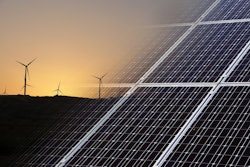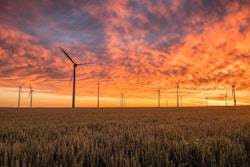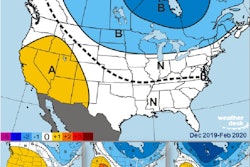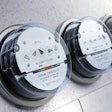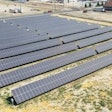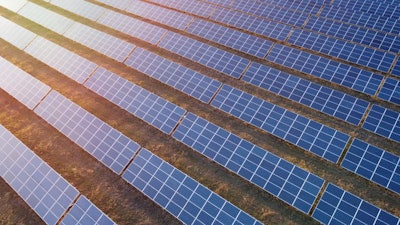
Solar and wind energy power the Feed Technology Center and other facilities at the University of Illinois Urbana-Champaign campus
TheFeed Technology Centerat the University of Illinois runs on clean energy, but it doesn’t come from wind orsolar panelslocated on campus rooftops.
In 2012, theUniversity of Illinoisentered into a contract with energy developer Phoenix Solar South Farms called a power purchase agreement (PPA). According to the terms of the agreement, the developer would build, maintain and operate a 20-acre, 5.87 megawatt (MW) solar farm on a plot of land located a few miles from the center of the University of Illinois Urbana-Champaign campus. In exchange, the university would agree to buy all the power generated by the farm.
当时,他们达成了协议,安排ment was expected to cost US$5.3 million above what the university would normally pay for power. But campus leadership had made a pledge to achieve carbon neutrality as soon as possible, and finding a way to get clean energy — even if it couldn’t generate everything on-site — was part of the university’s strategic plan to meet this goal, according to Steve Breitwieser, manager of communications and external affairs for University of Illinois Urbana-Champaign Facilities & Services.
In time, however, the solar farm proved to be a financial asset. As regional power prices began to rise, the fixed cost of the power purchase agreement eroded the premium the university expected to pay, Breitwieser says. Meanwhile, the cost of solar energy continued to decline. When the university entered a power purchase agreement for a second 12.32 MW solar farm, the university anticipated it would generate financial savings in addition to the environmental good will. It outperformed those expectations, Breitwieser says.
Today, the energy from both solar farms, as well as from a wind farm with which the university has also entered a PPA, flows into the mix of energy that runs The Feed Technology Center and other university facilities.
“The PPAs removed the need for the university to provide tens of millions in up-front capital to invest in building and maintaining new solar arrays and wind farms while securing renewable energy credits from new, renewable sources,” Breitwieser says. “The PPAs also provided a fixed price that has helped provide greater budget certainty and reduced energy costs with the dramatic price increases experienced in the energy markets.”
Increasingly, you don’t need to be a whole state-run university to explore alternative energy sources like power purchase agreements. The energy world is awash in innovation. Wind and solar energy is often cheaper than conventional options, and new ideas including battery storage, smart meters and virtual power plants offer avenues to save energy and quite possibly earn money in the process. So if you haven’t shopped around for energy recently, experts say, you might want to, and you might want to consider options beyond your local utility’s standard offerings.
Solar price hedging
Alternative energy sources like wind and solar have become increasingly attractive, particularly for large power users, in recent years. According to theU.S. Energy Information Administration, the typical cost of energy production now runs about US$33.83/MWh for solar, compared with US$39.94/MWh for natural gas, US$40.23/MWh for wind, and US$82.61 for coal.
Installing solar on one’s own farm can result in significant energy savings, according to Stanley Solomon, an extension educator specializing in natural resources, environment and energy at the University of Illinois. But there is always a question of how to pay for the up-front cost of installing panels, and the ongoing need to maintain and operate those solar panels. Running what is essentially a mini power plant on-site also brings uncertainty about what, exactly, your energy will cost — utilities may or may not pay for surplus energy when the sun is brightest, and you’ll still need a source of power when the sun sets.
This is where a PPA can come into play. Power purchase agreements are typically long-term contracts spanning 10-15 years in which an energy user agrees to pay a renewable energy project developer a fixed price in exchange for a fixed amount of energy and the associated renewable energy credits, according to Rob Collier, vice president of the energy marketplace atLevelTen.
Each contract has its own specifics, but in general PPAs fall into one of two categories. In a physical PPA, the developer builds an energy project at a specific site — sometimes on the buyer’s property — and the electricity flows directly from that project to the buyer’s facility. The buyer may eventually assume ownership of the energy project at the end of these contracts, depending on the terms of the agreement.
There are also virtual PPAs in which the energy generated doesn’t flow directly from the project in question to the buyer. In a virtual PPA, Collier explains, the developer sells the power from the project to utilities or wholesale markets for the going market rate. The developer calculates the difference between the project’s earnings and the fixed price set in the PPA.
“If the difference is positive, the developer will pay the buyer the difference,” Collier says. “If the total is negative, the buyer pays the developer the difference.”
对于开发人员,PPA提供了保证revenue that can be used to secure financing for their projects, Collier says. In exchange the buyer receives renewable energy credits that can be used to offset a company’s carbon emissions. And increasingly, PPAs are used by companies as a hedge against rising energy prices and the financial risks that can come with meeting one’s own energy needs.
“The whole thing is a way to lock your energy costs, or a certain percentage of your energy costs, down for some period of time,” Solomon says. “That’s what makes power purchase agreements, from a business standpoint, better. It gives you a more defined result.”
Amid today’s rising energy costs, it can also come with the advantage of locking in energy at a lower cost than may be available in the future — a potential that has seen the popularity of PPAs soar in recent years. In 2022, the LevelTen Energy Marketplace saw buyers and developers enter contracts for a record 25 million megawatt hours of electricity.
Emerging alternatives
For those considering alternative energy sources, power purchase agreements may not be the only interesting game in town. As an educator on energy resources, one development Solomon has followed recently is the growth of community solar.
Community solar projects are essentially small power plants built by independent power generators to serve specific subscribers within a geographic area. But community solar is more cooperative than a PPA, combining the resources of multiple individuals, businesses or other entities in order to finance the construction of the solar farm. In return, the benefits of the solar farm are distributed across the entire subscriber base.
The specific rules around who can participate in a community solar project vary from one region to the next, but Solomon believes it could be an option worth looking into as a potentially more straightforward, more hands-off alternative to a PPA. And many community solar projects, he says, might appreciate having a large customer such as a feed mill to act as a sort of anchor client for the overall development.
Another emerging opportunity is a concept called a virtual power plant, Solomon says. A virtual power plant is an energy aggregator that uses technologies such as smart meters and on-site energy storage to buy and sell electricity at financially advantageous times. Essentially, when power costs are low, the virtual power plant ramps up power use by charging up on-site batteries and even electric vehicles that may be plugged in at a particular location.
Then when power costs rise during peak use hours or critical events like power outages, the virtual power plant sells the power stored in those on-site batteries back to the utilities at premium prices. The nation’s large virtual power plant operators also have the capacity to access some manufacturing equipment remotely in order to increase or decrease their customer’s power use according to hour-by-hour electricity prices. Many virtual power plants also offer plans for sharing in the profits associated with energy sales during peak hours, but the savings alone may be beneficial, Solomon says.
“Especially in something like a feed mill where you get hammered by the highs … anything you can do to reduce that demand charge is big, huge,” he says.
The virtual power plant concept is still relatively new, and not yet available in all areas; California is the largest virtual power plant market in North America by a wide margin. But it could present some interesting opportunities in the future, says Solomon, who recently attended a webinar where a school district talked about enrolling electric school buses in a virtual power plant program to earn money while the buses sit idle during the day.
Individual considerations
As with any business decision, whether any of these emerging energy options work for an individual feed mill will vary according to individual circumstances. And regional variations from one energy market to the next can further complicate matters. Where one utility might welcome PPAs and virtual power plants, another may not even allow them.
In the U.S., areas served by wholesale electricity markets generally have the greatest access to options such as PPAs and virtual power plants, according to Collier. Western states, excepting California, and much of the southeast still have limited direct access to energy markets. Here, the only option is often to work through your utility, Collier says.
Even so, it’s worthwhile to reach out to your local utility and find out what it might be willing to negotiate, Solomon says. Electrical demand is growing at a rate utilities haven’t experienced in recent history, which means electric companies are actively looking for solutions that will reduce pressure on the grid and keep prices from escalating further. And many utility companies also face mandates that require a certain percentage of their new electric generation to come from resources like wind or solar power. A PPA with a large feed mill can often help utilities meet both of these objectives.
“I think some will be surprised when they go to their utility — some utilities are looking for that help,” Solomon says. “There is a lot of movement that needs to occur and they’re at that point where anything you can do helps them out.”
That said, Solomon says it’s also important to note that any power purchasing strategy or negotiation should follow an initial effort to make the feed mill as energy efficient as possible. The cheapest power of all is the power you don’t use, he says, and you don’t want to lock yourself into a long-term agreement to buy more electricity than you need.





